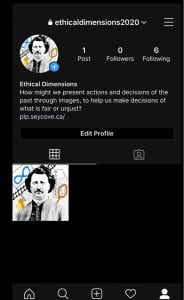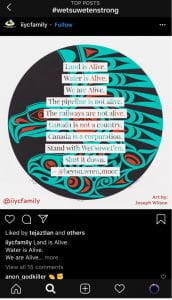For this post I will be sharing what I have learned in our recent project all about Louis Riel and ethical dimensions. We took look at the history of Louis Riel and decided whether his execution was ethically correct. We also had to research other events in the past and decide whether the result was ethnically correct as well. We did the second part in partners, and then created three images to represent whether the event was fair or unjust; these images were posted onto a class Instagram account. Here is how the project went.
In our partners we had to choose an event that has happened in the past that affected people on a large scale. My partner ( Ally ) and I chose to focus on the abolishment of slavery. Of course we had to have a little bit of background information in order to create three images that show this unethical event. We came up with ten questions that we thought we needed in order to to create our images. We also created one driving question which would be the base of our images. This was very helpful personally because I was able to get a better understanding of our topic really fast, and some of the questions gave me ideas for images I might want to draw or recreate.
This information went into an ‘ethical dimensions’ worksheet. We then used the information we researched and compared the ethics of the situation back in 1806 to now. All it means is that we compared slavery and how it was justified back then and how it is viewed today. We also added information about things like who was involved, when did the event happen, and what other events were happening at this time. Based on this, we could understand why these events happened, how people back then may have seen this as ethical because of what other events were going on at that time, but nowadays we understand that these practices were unethical and despicable.
A milestone in our project that helped us decided whether this event was ethical was the Louis Riel biography that we read as well. We learned all about who Louis Riel was and what he stood for. The reason his biography was a good source to help us with ethical issues is because Louis Riel, as we learned, did some questionable things, but he did them for the good of his people, or so he believed. In this situation was his execution fair or unjust? Was it ethically correct even though he did these things for his people? I thought this part was difficult at times because I had to know the entire situation. If only one point of view is expressed then there is no way I could judge the situation. Overall I think this biography helped me to be able to understand whether a situation is ethical or not.
For our historical event, the abolition of slavery, it was fairly easy to tell that slavery was unethical because people were not only selling other people for profit, they were also making them do hard labor with not pay, treating them worse than animals. The next step was creating three images, one image was to be drawn, one was a quote with a background and lastly one image was free choice. I thought that the free choice was a really good idea because it allowed us to create whatever we wanted to represent our historical event, and for this we had a lot of ideas. We were both open to trying new ideas which made this part really engaging and fun!
We decided to draw on an image of a slave ship and show the evilness of the people who owned and sold these poor people, I created this image by using Sketches Pro to draw cartoon versions of people. Ally created the quote and added a pattern in the background, and for our free choice we decided to make a shirt. It was quite a big risk because if the shirt did not come out well then our free choice would have been ruined.
I was able, however, to create an image that we could put on the shirt and Ally was able to print the image on the shirt, so in the end it worked out quite well. The image on the front is a blade splitting a chain that was holding two hands. The blade is made of names of well known people who helped free slaves and had great public influence. The hands represent the slaves and the chain represent the act of slavery. We think it is a powerful image.
I am proud of the image and product that we made. I had little idea what we were going to do in the beginning but moving on I found it was easier to think of things to represent how unethical our chosen historical event was. We were able to creatively show the unjustness of a very important part of history. This can be tough because this is a very serious part of history that can never repeat itself, so we had to be careful with everything we created as not to make light of the situation.
To conclude I think we succeeded in creating images that reflect our understanding of ethical dimensions and how we can reflect on an event in the past and judge whether what happened was fair or unjust.











Great post Noah. Keep up thy great work. I think there should be a little more emphasis on the competencies. Nice job